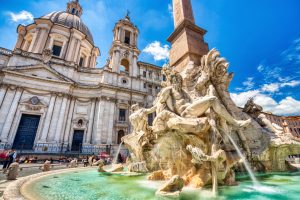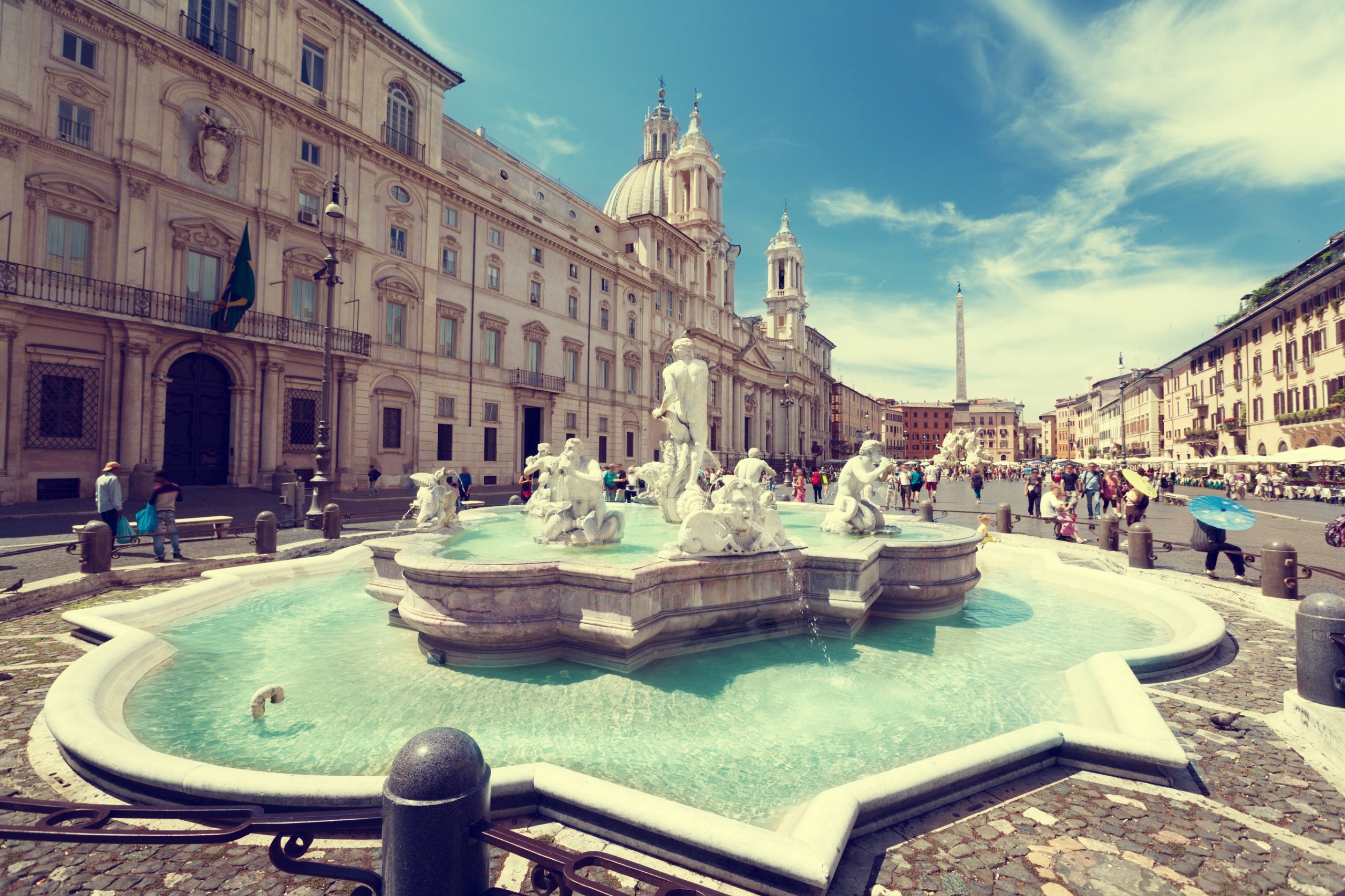Piazza Navona is my favorite place in Rome, at the heart of Renaissance papal Rome. It is a noble, symmetrical place that reproduces, in length and breadth, the stadium of Domitian, the “circus agonalis”, as it was called, a name that was corrupted through the centuries to N’agona, and then Navona. The houses, the churches and the palaces that surround the piazza are set on the old seats and corridors of the old stadium. Two thousand years ago, chariots could be seen racing around this oval space. The emperor Domitian used to flood the stadium and provide gladiatorial combats and naval battles, “naumachiae” for the Roman populace. This oblong piazza (240 meters long and 65 meters wide) is not far from the Pantheon, also called the old baths of Agrippa: it was therefore relatively easy to supply it with waters flowing from the Roman hills.
This piazza contains three fountains all set along its median line. The central fountain is the magnificent and spectacular Fountain of the Four Rivers of Bernini. This colossal fountain was completed by Bernini in 1651; on the north side of the piazza there is the Fountain of the Moor, designed by Bernini but executed by Mari in 1655. On the south side, there is the Fountain of Neptune executed by Giacomo della Porta in 1574. On the right side of the piazza – as you enter from the north – stands the church of Saint Agnes, completed by Borromini, Bernini’s archrival, in 1657. Churches and palaces stand almost shyly at the sides, making the fountains the focus of the space. In this piazza popular feast, like Epiphany, were, and still are, celebrated.

In the middle of the second millennium, there was no fountain here, until the time of Pope Gregory XIII, when the passion for fountains started. Pope Pius IV has the old Roman aqueduct of the Acqua Virgo (virgin water) repaired, so that water could be channeled without intermission.
The Fountain of the Four Rivers is regarded as the masterpiece of Bernini, the greatest and most imaginative architect of the Baroque Rome. At the center of the fountain there is an obelisk of red oriental granite brought from the circus of Maxentius, topped with a bronze dove and an olive branch, the emblem of the Pamphili family, the family of Innocent X, the pope who commissioned the fountain. Bernini placed the obelisk on four flying buttresses of white granite, crossing each other at right angles. Thus the obelisk appears to miraculously rest on this arch, forming underneath a grotto with four openings.
With such clever and imaginative architectural devices, the obelisk appears to float and rise out of nothing. The bases of the four flying buttresses are enlarged at the bottom, so that they can carry the gigantic figures of the four rivers gods carved in Carrara marble. Beneath the grotto, additional jets of water spurt out, and a river horse dashes through an archway, as if scared by an approaching lion: the lion has come out to drink the water under the shade of a palm tree cut in high relief in the rock. A serpent crawls on the top of one of the rocks and a mass of cactus grows upward towards the bright Roman sky. In the lower basin, two monstrous fishes contort in the serpentine manner typical of Baroque art. This fountain, executed between 1648 and 1651, shows the fertility of Bernini’s genius. Bernini loved water, and this splendid fountain is spectacular not only for its forms, but also for the shimmering reflections of the water. The bottom part of the fountain is made of rough marble that gives the impression of marine rocks.
At the four corners sit the colossal (between four and five meters high) marble personifications of the four rivers, as described by classical iconography: the Nile, representing Africa, the Danube, representing Europe, the Ganges representing Asia, and the Rio de la Plata, representing the Americas. (In those days they did not know that the longest river of the Americas is the Amazon river). The four rivers, meant to represent the whole world as it was known at the time, were also meant to manifest the fact that the power of the Catholic church pervades the four corners of the world. Bernini also cleverly reproduced the flora and the fauna of the four continents. The fountain is an example of Baroque architecture at its highest peak, but also shows the passion for exploration people felt at this time. The obelisk at the center of the fountain signifies the eternal quality of the Catholic faith.
Legendary is the rivalry between Bernini and Borromini, great architects who lived at the same time in papal Rome. The figure of the Nile covers his head, to show that its source had not been discovered yet; malicious critics said that Bernini covered his face because it faced the church of Saint Agnes, built by his rival Borromini. Just as the Nile covers his face not to see Borromini’s church, the figure representing the Rio de la Plata lifts his arms defensively, as if to protect himself from its fall. These of course are legends, since Borromini completed the Church of Saint Agnes several years after Bernini’s fountain was in place.
During the life of Pope Innocent X the Feste of the Lago di Piazza Navona began. Every Sunday in July and August the outlets were stopped and the piazza was flooded. The nobility went around in their carriages while the water reached up to the middle of the wheels. In the piazza, refreshments were served, people splashed about, children swam in the low waters. At the sound of the Ave Maria the piazza was drained, and the waters once more flowed to Bernini’s fountain. These delightful summer festivals pleased the people of Rome as much as the “naumachiae” held here fourteen hundred years earlier.
Here am I, spending a lazy afternoon in the warm sun of an early Roman spring, sipping San Pellegrino at a café right in front of the Fountain of the Four Rivers observing tourists and children playing with the water and fending off pigeons: it does not get any better, this is “la dolce vita”.






























